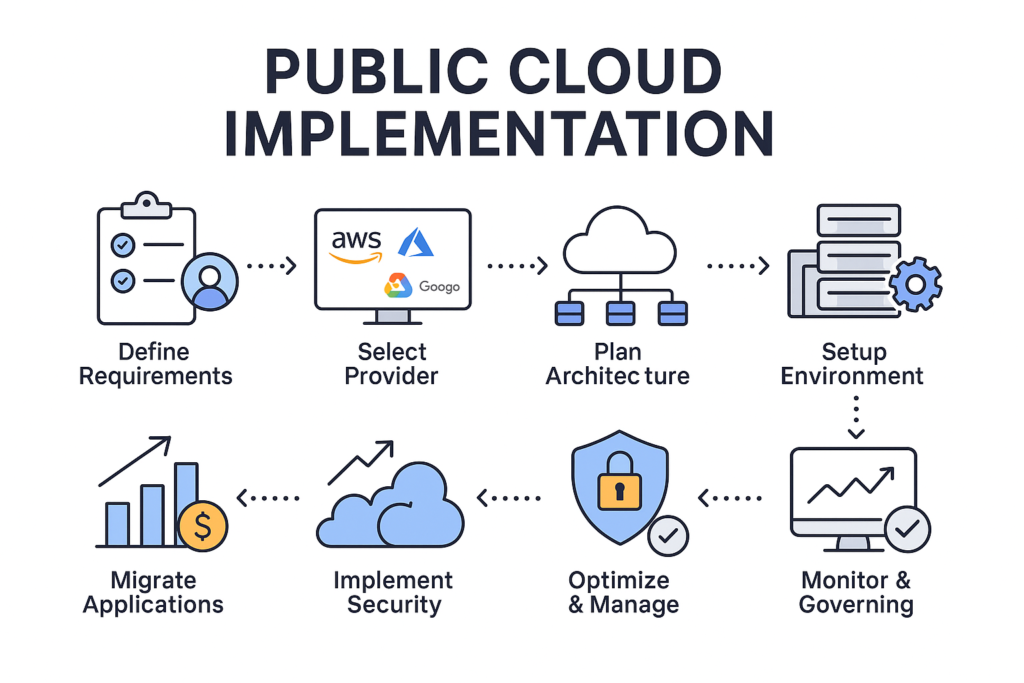
Introduction: Why Public Cloud Matters in 2025
The public cloud has become the fastest-growing segment in modern IT infrastructure. As businesses shift from legacy on-prem systems to scalable and cost-efficient cloud platforms, the public cloud stands out as the most accessible and powerful option. Whether you are a startup building your first application or an enterprise migrating legacy systems, successful implementation of the public cloud impacts performance, security, and ROI.
This article explores what public cloud is, why it matters, and most importantly, exact steps to implement it in real business environments.
What is Public Cloud?
A public cloud is a computing model where resources such as servers, storage, databases, and software are delivered over the internet by third-party providers.
The most popular public cloud platforms include:
- Amazon Web Services (AWS)
- Microsoft Azure
- Google Cloud Platform (GCP)
Unlike private cloud, the infrastructure is shared, but the data and workloads remain isolated and secure through virtualization.
Key Features of Public Cloud
✔ On-Demand Scalability
Scale resources instantly without physical hardware.
✔ Pay-as-You-Go Pricing
Pay only for what you use — ideal for startups and enterprises.
✔ High Availability & Global Reach
Deploy applications in multiple regions for low latency and better performance.
✔ Managed Security & Compliance
Cloud providers offer built-in encryption, IAM, firewalls, and compliance standards like SOC2, ISO 27001, and HIPAA.
Why Businesses Choose Public Cloud
1. Cost Efficiency
No infrastructure investment. Reduced CAPEX. Seamless OPEX management.
2. Rapid Deployment
Launch servers, apps, and workloads within minutes.
3. Flexibility & Innovation
Support for AI, analytics, automation, and DevOps at scale.
4. Disaster Recovery & Backup
Multi-zone and multi-region protection built into the platform.
🚀 How to Implement Public Cloud: Step-by-Step Guide.
This is the most important part of the blog — and the most SEO-targeted section.
Below is a complete implementation roadmap to help companies adopt the public cloud successfully.
Step 1: Define Business Requirements
Before deployment, clarify the following:
- Migration goals
- Compliance or data residency needs
- Estimated cloud usage
- Required applications
- Security standards
- Budget
SEO Tip: Keywords like “public cloud implementation checklist” and “cloud migration steps” help rank this part.
Step 2: Select the Right Public Cloud Provider
AWS – best for scalability
Azure – best for enterprise integration
GCP – best for analytics and AI
Evaluate each provider based on:
- Cost structure
- Native tools
- Regional availability
- Compliance requirements
Step 3: Plan Cloud Architecture
A well-designed architecture improves performance and reduces costs.
Key architecture components:
- VPC / Virtual Network
- Subnets (public & private)
- Security Groups / Firewalls
- Load Balancers
- Identity & Access Management
- Storage (S3, Blob, Bucket)
- Databases (RDS, SQL, NoSQL)
Follow the Well-Architected Framework from:
- AWS
- Azure
- GCP
Step 4: Setup Cloud Environment
1. Create Cloud Accounts
Set up AWS / Azure / GCP accounts with MFA and org hierarchy.
2. Configure IAM Roles and Policies
Follow Zero Trust principle.
3. Create VPC / Network
Define CIDR ranges
Create subnets
Configure NAT, Internet Gateways
4. Configure Monitoring & Logging
Use CloudWatch, Azure Monitor, or GCP Operations.
Step 5: Migrate Applications & Data
You can migrate via:
✔ Lift and Shift
Move servers and applications without major changes.
✔ Refactoring
Modify the application to use cloud-native services (containers, serverless).
✔ Re-Architecting
Fully rebuild for cloud scalability.
Migration tools:
- AWS Migration Hub / DMS
- Azure Migrate
- Google Migrate for Compute Engine
Step 6: Implement Security Best Practices
Security is a crucial part of SEO content since Google prioritizes trustworthy sources.
Follow:
- IAM least privilege access
- Encryption at rest & in transit
- Cloud firewalls and WAF
- Backup strategy
- Routine patching
Step 7: Optimization & Cost Management
Use:
- AWS Cost Explorer
- Azure Cost Management
- GCP Billing Reports
Focus on:
- Autoscaling
- Rightsizing instances
- Stopping unused resources
Step 8: Continuous Monitoring & Governance
Set up:
- Alerts
- SLAs
- Compliance checks
- Automation workflows
This ensures smooth cloud operations 24/7.
